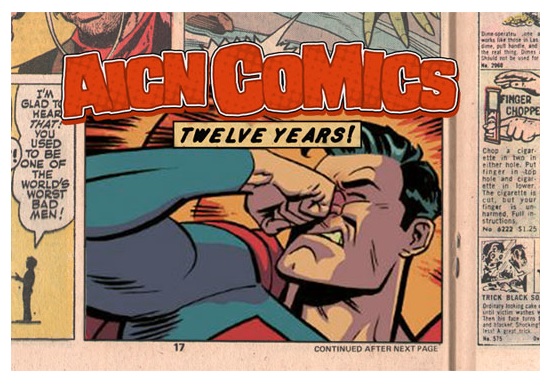
(Click title to go directly to the review)
COMICS IN FOCUS: CHRIS CLAREMONT’S X-MEN Documentary (2013)
Advance Review: HARLEY QUINN #0
UMBRAL #1
THOR: THE GOD OF THUNDER #15
Indie Jones presents: LAPTOP GUY #1
THE SHADOW/GREEN HORNET: DARK NIGHTS #5
MARVEL KNIGHTS X-MEN #1
ARCHER & ARMSTRONG #15
THE SHAOLIN COWBOY #2
DEADPOOL #19
Advance Review: SNOWPIERCER: THE ESCAPE Vol.1
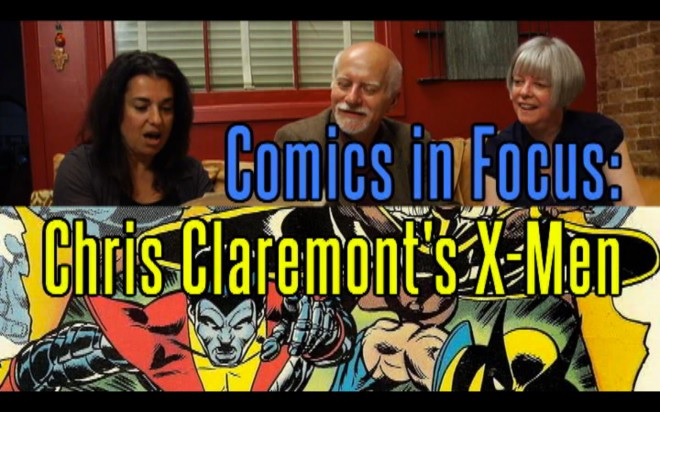
COMICS IN FOCUS: CHRIS CLAREMONT’S X-MEN Documentary (2013)
Directed by Patrick MeaneyStarring Chris Claremont, Jim Shooter, Len Wein, Louise Simonson, Ann Nocenti, Peter Sanderson, Sean Howe, Tom McLean, Jason Aaron
Find out more about this film at Respect Films/Sequart
Reviewed by Ambush Bug
X-Men, along with the Avengers, are what got me into reading comics. The flawed but heroic characters looking unlike any other characters I’d ever seen before were instantly appealing to me as a kid wandering around the old 7-11 store and spinning the creaky spinner rack. Though I loved creepy books like HOUSE OF MYSTERY, I think it was the way Nightcrawler looked that made me instantly pick it up and dive in, and soon after an X-Fan was born. I read the X-books through the Eighties and into the Nineties, but once the second X-title X-MEN came out, it felt like something was missing from the books. Soon, the X was diluted to a point that it didn’t feel like I was reading a story anymore, but a product. As a result, I did something that I never thought I would do—I walked away from the X-books, and though occasionally I dip back into the books when I have to read them for our weekly podcast, I haven’t looked back. To this day, as a person who was led into the world of comics by those gifted children at Xavier’s school, it saddens me that those comics lack the guidance, the succinctness, and the power that it once did.
Watching Patrick Meaney’s COMICS IN FOCUS: CHRIS CLAREMONT’S X-MEN documentary, I couldn’t help but realize that the end of Claremont’s run really did signify the end of my interest in X-Men. I didn’t know it at the time, as I didn’t follow the behind the scenes stuff half as much as I do now, but his departure really did suck the soul from the books. Now, before you tell me to eat shit and that I’m an old codger and that there are perfectly good X-MEN books out there today, I’m sure that’s true. But Meaney’s documentary does a great job of illustrating the death of creative expression and stories that matter at the House of Ideas and the birth of the corporate Marvel hype machine that frustrates readers when every crossover event that is supposed to crack the world in half doesn’t and the only new idea is a reboot of an old idea with a fresh coat of paint.
Meaney’s camera focuses mainly on the story from Claremont’s perspective, and while I’m sure there are other POVs that might counter his story, the rest of the cast seems to support it. The fiery relationship Claremont had with Jim Shooter, who was the Marvel Editor In Chief at the time of his most popular run on THE UNCANNY X-MEN, seems to be looked back on with a mutual respect as both are interviewed at length about the arguments the two had over editorial and narrative decisions that happened along the way (one of which being the first resurrection of Jean Grey in the new X-FACTOR title after Shooter was the one who held fast that Grey would forever stay dead). The documentary goes into detail about how Claremont spread himself paper thin towards the end of his run in order to keep control of the X-Men, which was quickly becoming a product rather than a story. It’s kind of a sad and tragic tale of a man who put it all into his writing and at the end of the day had little to show for it.
Sure, there are a lot of bad feelings when Claremont’s name is mentioned now. His occasional dips back into X-Men do feel like the writer has lost his personal stake in the characters he’s helped build. Some say this is an indication of a writer whose inkwell has run dry, but from the way it plays out in this doc, it feels more like a person who had his heart broken and has never recovered from it.
The documentary is not solely told through Claremont’s words, but also from former Marvel editors Len Wein, Ann Nocenti, Louise Simonson, and the aforementioned Jim Shooter, as well as Marvel historians Peter Sanderson, Sean Howe (who wrote the amazingly informative MARVEL COMICS: THE UNTOLD STORY), and Tom McLean (who wrote MUTANT CINEMA). Even one of today’s top writers, Jason Aaron, chimes in on Claremont’s influence and the raw deal he got when things got too corporate. If anything, this documentary can serve as a cautionary tale about writing for the Big Two, which is a dream of so many when the reality is that the characters you grew up loving because they evolved have failed to mutate over the last few years because it’s not the creative spirit that drives them but the all mighty buck. Though it’s not the most uplifting of stories, it is a documentary that pulls the curtain back on the way comics are done today, and sometimes what’s back there isn’t so pretty.
Director Meaney’s documentary is focused mainly on Claremont’s X-Men years, which is too bad because I’d love to see the writer’s life in a broader scope as Meaney has done with his films about Warren Ellis (CAPTURED GHOSTS) and Grant Morrison (WALKING WITH GODS); still, Meaney is able to stay focused here on the writer himself, in his own words, about his most significant addition to comics as a medium. Meaney has an uncanny ability to find out what makes these writers tick and does so here again with Claremont, who might be a bit disgruntled, but with the way he was wrenched away from the X-Men after dedicating almost 20 years on the title, who can blame him? It is interesting to see that almost all of the films that have been released have Claremont all over them (DAYS OF FUTURE PAST being a Claremont story as well). Interspersed with cosplayers wearing pretty amazing costume renditions of the characters he helped create, COMICS IN FOCUS: CHRIS CLAREMONT’S X-MEN is a documentary no comic book fan of the letter X should miss – if only to see that the heroic and villainous drama that occurred in between the panels rivaled that inside the comics themselves.
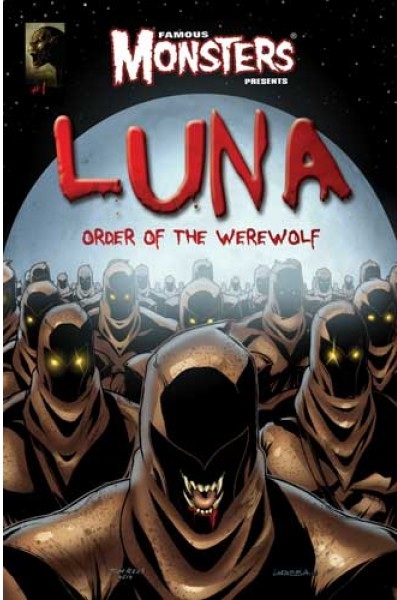
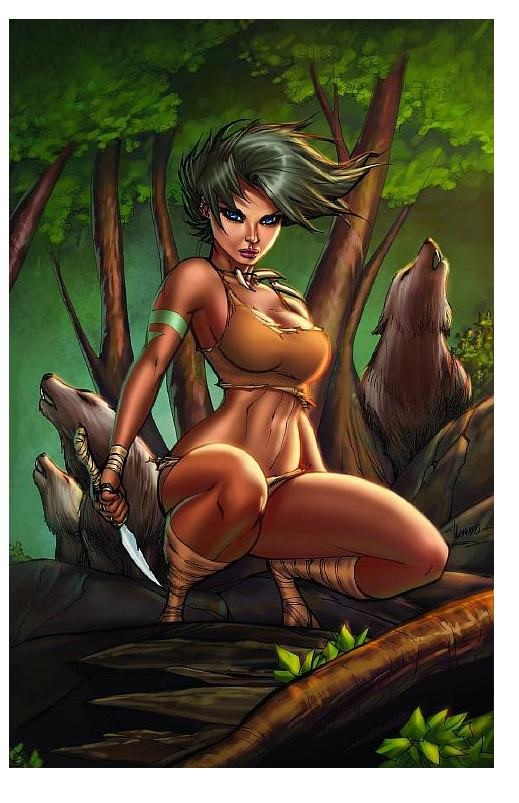 Ambush Bug is Mark L. Miller, original @$$Hole/wordslinger/writer of wrongs/reviewer/interviewer/editor of AICN COMICS for over 12 years & AICN HORROR for 4. Mark’s written comics such as THE TINGLERS & WITCHFINDER GENERAL, DEATHSPORT GAMES, NANNY & HANK (soon to be a feature film from Uptown 6 Films), Zenescope’sGRIMM FAIRY TALES Vol.13 & UNLEASHED: WEREWOLVES – THE HUNGER and a chapter in Black Mask Studios’OCCUPY COMICS. FAMOUS MONSTERS’ LUNA: ORDER OF THE WEREWOLF (co-written with Martin Fisher) will be available soon in trade. Mark also wrote the critically acclaimed GRIMM FAIRY TALES PRESENTS THE JUNGLE BOOK and its follow up THE JUNGLE BOOK: LAST OF THE SPECIES! Follow Ambush Bug on the Twitters @Mark_L_Miller.
Ambush Bug is Mark L. Miller, original @$$Hole/wordslinger/writer of wrongs/reviewer/interviewer/editor of AICN COMICS for over 12 years & AICN HORROR for 4. Mark’s written comics such as THE TINGLERS & WITCHFINDER GENERAL, DEATHSPORT GAMES, NANNY & HANK (soon to be a feature film from Uptown 6 Films), Zenescope’sGRIMM FAIRY TALES Vol.13 & UNLEASHED: WEREWOLVES – THE HUNGER and a chapter in Black Mask Studios’OCCUPY COMICS. FAMOUS MONSTERS’ LUNA: ORDER OF THE WEREWOLF (co-written with Martin Fisher) will be available soon in trade. Mark also wrote the critically acclaimed GRIMM FAIRY TALES PRESENTS THE JUNGLE BOOK and its follow up THE JUNGLE BOOK: LAST OF THE SPECIES! Follow Ambush Bug on the Twitters @Mark_L_Miller.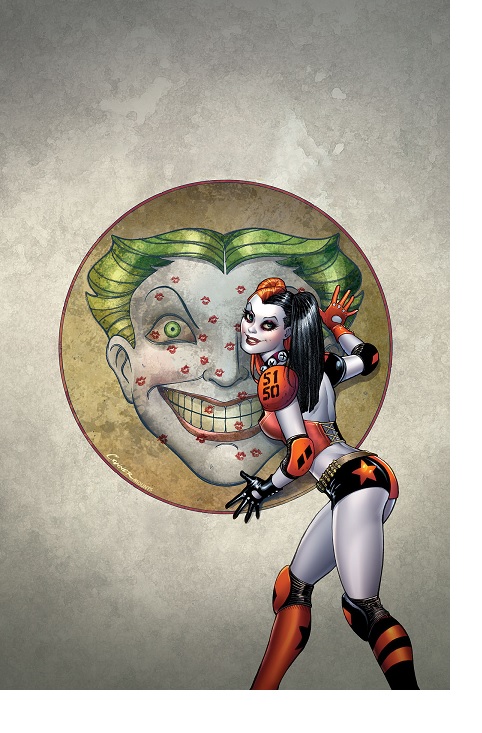 Advance Review: In stores today!
Advance Review: In stores today!HARLEY QUINN #0
Writers: Amanda Conner, Jimmy PalmiotiiArtists: Charlie Adlard, Art Baltazar, Darwyn Cooke, Becky Cloonan, Tony Daniel, Sam Keith, Bruce Timm, Jim Lee, Stephane Roux, Tradd Moore, Chad Hardin, Adam Hughes, Dave Johnson, Dan Panosian, Jeremy Roberts, Walter Simonson
Publisher: DC Comics
Reviewer: Optimous Douche
Uhhhh…wha…hmmmm…
This is the first time a comic has left me absolutely speechless at the end. I know how to handle an excellent comic, a terrible comic, a comic with epic impact and comics with no continuity concern, comics with bad art, marginal art, hell sometimes practically no art, and most importantly comics that break the fourth wall with reckless one-off abandon and frivolity. However, I have never reviewed a comic that relishes in and obliterates every grievance we’ve had about comics while breaking the fourth wall and while still carrying continuity. Seriously, I’m dumbfounded and enthralled all at once.
The premise is simple…ish. OK, that’s a lie; the premise is easy to follow, but far from simple. Harley wonders what it would be like to have her own comic, and away we go on a roller coaster of all time and space. This cacophony are the puppets of Ms. Quinn and the puppet master,s as their ids and Harley’s not only break the fourth wall, but atomize itwith the force of the Hadron Collider. Our guide and Harley’s is the omnipotent editor delighting in their manipulation of Ms. Quinn, and as I mentioned earlier peeling back the scab of our collective jabs towards the modern state of comics.
Since this is written in the same self-deprecating manner as, say, MAD magazine, I’ll follow in suit. I’ve never seen balls this big protruding from Technicolor camel toe, especially with the ending where Harley is given a deed to real estate from an unknown Arkham benefactor. So, this is real (from a comic universe perspective), but it’s not since the DC creators can’t live within the DC universe. Without the addition of this last page I would have just laughed off this book, but with it…well, you saw my eloquent lead-in line already.
The best I can do for a review is say whose art titillated me the most.
Amanda Connor, I simply love top to bottom – cinema, lines, scope, all beautiful. Tony Daniel’s pot shot at the Mets and the corporatization of all East Coast parks with a Mecha-Harley devouring all made the Jersey boy in me laugh out loud. Panosian gives a welcome stylistic slap to the face with his “Mad Men” parody, followed up by another slap to the face from the editor at Simonson’s lack of backgrounds. Laughing, they recycle a page of yore for Jim Lee as the team mocks the mad amount of comic bank he’s made over the years.
Everyone else follows in suit – Cooke is kitschy with Catwoman and Harley, Moore adorable, Keith is certifiably insane and Jeremy Roberts is a new talent to be reckoned with--sweet baby Jesus is that some beautiful stuff.
This is definitively a piece for art aficionados and not the person who imbibes this medium for stories. Also, if your comics require gravitas steer clear. While I may question the nature of this book, it doesn’t make my blood boil. I’m OK with fun and I’m fine without shutting off the literal voices that scream in my head. I have no doubt that while issue 1 was set up in 0, it will be reiterated in a much more serious tone once Harley’s title enters the world of real numbers.
Optimous Douche has successfully blackmailed BottleImp to draw purty pictures for his graphic novel AVERAGE JOE coming out in 2013 from COM.X. When not on Ain’t It Cool, Optimous can be found talking comics and marketing on robpatey.com and just marketing on MaaS360.com.
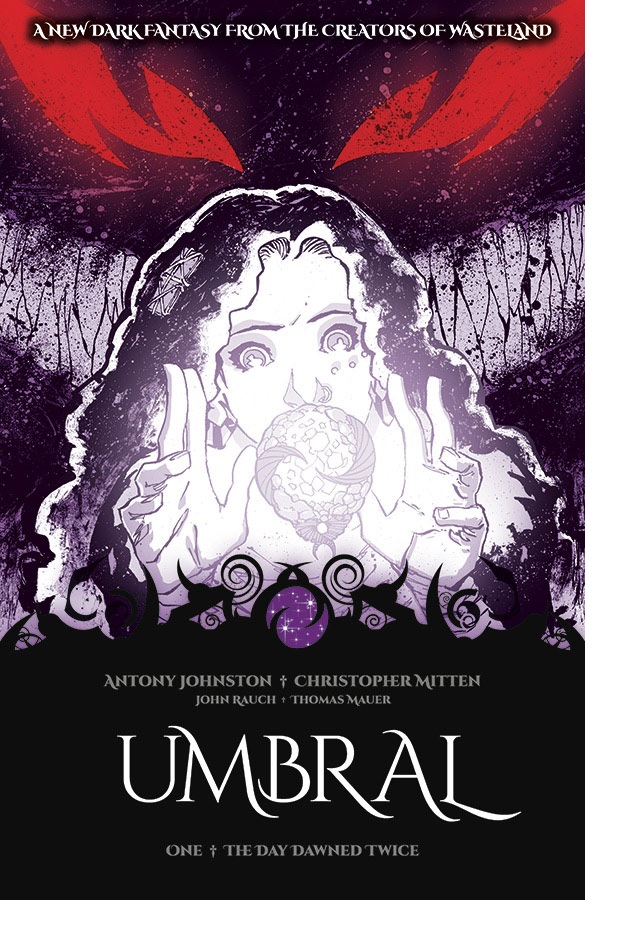
UMBRAL #1
Writer: Antony JohnstonArtist: Christopher Mitten
Publisher: Image Comics
Reviewer: Humphrey Lee
Picking up this comic it dawned on me that full-scale fantasy is not exactly something we get often in the world of comic books. Now, obviously we get plenty of fantasy tales in the medium so interpretations as to the measure of what I am talking about may vary, but I am more thinking in terms of something fully realized in the sense of fully realized realms and kingdoms and dimensions and species and on and on and on. Maps! With factions and little open triangles to show mountains and shit with ominous sounding locations in between. Stuff like that. Again, not saying we do not ever seen these kinds of titles; just that when you really consider how many comic books are out there, it’s kind of shocking that more of these pieces of genre do not exist. Except that it’s not at all, because of the word “logistics” existing. You need the story, obviously, and all the planning that entails, plus you need a publisher willing and able to sell something that will (hopefully) span years and probably take a while to gather steam and readership. Basically, you need a creative team like Antony Johnston and Christopher Mitten, who have shown this tenacity before, and you need a publisher like Image who is so at the top of its game now they can put their muscle behind pretty much anything these days.
If there is anything I want to give the dynamic duo behind WASTELAND and now UMBRAL here credit for in this debut it is how much it was not how I would have expected a “pilot issue” for such a large and looming story to play itself out. Thinking of that map and all those squiggly lines and adventurous names on them, you would think we were in for a slow burn, maybe some politicking or history telling and so on. And we are teased all of this after an opening two pages featuring something nightmarish with many sharp teeth as the story unfolds on the Kingdom of Fendin, its King and Queen and young Prince Arthir. We see the Mordent staff that is passed down the lineage and then comes THE MAP!!! and we’re still left to wonder where that opening came from as the prince starts running around the kingdom with a young girl and thief named, amusingly enough, Rascal. Groundwork is being laid, a little mischief is at hand, there’s some magic being hinted at, and it seems like we’re getting the info dose now and that lead in will also be our “to be continued” page (and it more or less is) after we spend most of the issue getting the lay of the land. And then it’s pretty much pure terror from page ten on as guards are found massacred, the King and Queen get nibbled on by shadowy beasts, and the Prince loses his goddamned arm whilst getting shunted off to god knows wherever, leaving Rascal – and the reader – to basically say “oh, fuck” in the face of all these happenings. The cover does say “Dark Fantasy”, after all…
Most of my enjoyment of this issue of UMBRAL can actually be placed on such a turnabout because it preordains what we can expect, which is the unexpected. Yes, the book opens up with some chaos, but even I did not expect to see Prince Arthir, who I figured would maybe be a partner in crime to Rascal (who you figure is some sort of main character since she’s on the cover, natch), to get whisked away sans an appendage. Overall it’s nice to see a book be so surprising while also laying down some familiar groundwork with an assortment of mystical artifacts that the kingdom’s fate looks to hinge on now, some shadowy figures that know all too much about what seems to be happening, and a capable lead with hidden potential that is currently in way over her roguish head. The world of UMBRAL promises to be full of interesting figures, historical and magical lore, adventures stretched over an unsuspecting kingdom and all that good stuff, but Johnston and company do well to let us know this will also be a book hounded with some pretty terrifying events and enemies. After this first issue, we know we are going to be in for all the good things that a fantasy epic entails; they just went to a great length to emphasize the modifier before the f-word.
Speaking of “dark”, holy god does this book look freaking purple. It also looks very vibrant and unique – as Christopher Mitten art very much is with its line style – and actually looks better than I could have hoped because, admittedly, I don’t think I’ve ever seen Mitten’s art colored and have ever wondered how it would turned out. It turns out the answer is “lush”, and it was already a vibrant style just in pencils alone ala WASTELAND. Also, purple: though given the twilight happenings of the events of this book and the Umbral themselves, I get the extended use of that hue; I just wouldn’t want to see it become a habit, as it got somewhat distracting amidst all the carnage. But speaking of habits, and because I’m the master of the terrible column wrapping up segue, I hope UMBRAL becomes one for a lot of readers because, like the aforementioned WASTELAND, it’s a world brimming with potential. The book is very aware of itself and the genre it is playing in and how the comic book medium really can enhance that type of story, but it is definitely not afraid to muddle the mixture. We’ve seen a significant number of post-apocalyptic titles or space operas and whatnot take over this serialized form the past decade; it’s probably about time that we’re due someone taking a long form, episodic run at dark fantasy (and that isn’t named FABLES). That a tandem as talented as Johnston and Mitten is taking this shot at the genre only adds to the appeal and the anticipation I now feel after having had a floppy’s worth of initiation into this world. I look forward to at least a few years more of them as the world of UMBRAL becomes more “real.”
Humphrey Lee has been an avid comic book reader going on fifteen years now and a contributor to Ain't It Cool comics for quite a few as well. In fact, reading comics is about all he does in his free time and where all the money from his day job wages goes to - funding his comic book habit so he can talk about them to you, our loyal readers (lucky you). He's a bit of a social networking whore, so you can find him all over the Interwebs on sites like Twitter, The MySpaces, Facebookand a blog where he also mostly talks about comics with his free time because he hasn't the slightest semblance of a life. Sad but true, and he gladly encourages you to add, read, and comment as you will.
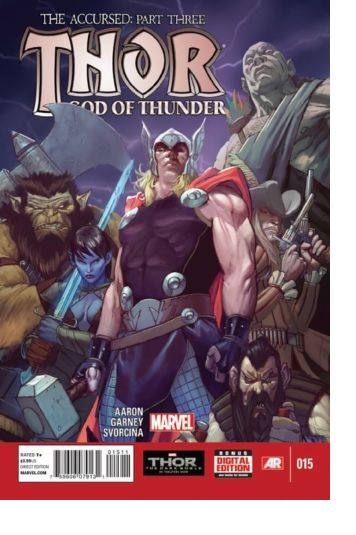
THOR: GOD OF THUNDER #15
Writer: Jason AaronArtist: Ron Garney
Publisher: Marvel Comics
Reviewer: Masked Man
You know, it's funny--after issue #12, which took place on Midgard (aka Earth), I figured we were going to get Thor on Earth for a while, doing his superhero thing. I mean, Aaron sure touched on a lot of possible subplots. But I suspect with THOR: THE DARK WORLD getting closer to theaters, someone with a higher pay grade told him to stick Malekith in the next story or else. So here we are, part three of “The Accursed”, or (using my best “Rocky and Bullwinkle” announcer voice) “Malekith goes on a killing spree”- which is pretty much all he did in the movie too.
As with the last big story arc, “The God Butcher/Bomb”, Aaron has a lot of good concepts going on in here (though I pray it doesn't run 11 issues again). Having only read THOR since the JMS days (and a few Masterworks by Stan Lee and Jack Kirby), I'm enjoying his take on Thor's divine world much more than what Matt Fraction had done. On some level I think the plot with Malekith is almost an afterthought (again, much like the movie) as the real story is us taking a tour of the Nine Realms, with this 'fellowship of the ring' Aaron created (to finish the comparison, the real story of the new movie was Thor and Loki).
To go over the plot, Malekith has been freed from Hel and is out to kill any dark elf that ever opposed him or did nothing while he was opposed. This not-too-surprisingly large group of dark elves has decided run to the other Realms and hide from him. The UN of the Nine Realms, the League of Realms, has assigned Thor to team up with a dark elf, light elf, troll, dwarf and (hill?)giant to put an end to Malekith--our 'fellowship of the ring'-inspired group. As you might expect, none of these characters care for each other and are just looking for a reason to break up. Spoiler time, matey: Thor, using what Thor knows best, decides that everyone getting sh!t-faced is the best way to get them to bond and see common ground in each other. This all works out fairly well, especially (serious spoiler time!) when Thor and the female dark elf get busy (I've often said we all just need to keep bonkin’ until we are all the same color). After that the team gets back to chasing Malekith, who is no match for the group, so he's been playing cat and mouse with them until the last page here, where one group of famous Thor characters, not part of the League of Realms, shows up to help Malekith--or rather, just get the pleasure of pounding the crap out of the fellowship.
So you can see, some pretty cool ideas in here, and all being well-explored and told by Aaron. Aaron often writes about the Nine Realms with just a ballz-out sense of wonder (I'm sure Kirby would be proud). With Malekith himself, I feel Aaron is trying too hard to recreate the evil that was Gor, the God Butcher, but you can't play the same card twice and expect the same results. Still, the overall favor of the story is greater than Malekith.
Artwork-wise, I'll say it: I wish Esad Ribic was still on the book. His work was much more unique and old world epic than Ron Garney's, who is more of a typical superhero artist (damn good one, too), though with no inker (which is usually a really bad idea) and Ive Svorcina's really great coloring job the pages still have that fairy tale feel I've come to expect from THOR: GOD OF THUNDER. So it's still a good looking book (FYI, Svorcina was Esad Ribic's colorist as well).
I'll stand by my assumption that Aaron was forced to write a Malekith story, and it shows, but he, Garney and Svorcina are still managing to put out a superior book. Well worth a read.
Learn more about the Masked Man and feel free check out his comic book GOLD STAR, CINDY LI: THREE OF A KIND and CAPAIN ROCKET at www.Toonocity.com

LAPTOP GUY #1
Writer: Jack LothianIllustrator: Sha Nazir
Publisher: Black Hearted Press
Reviewer: Mr. Pasty
Reading LAPTOP GUY was depressing, probably because it does such a bang-up job of holding a mirror up to the “new” way of life that is played out online for all your friends and family to see. Our protagonist, who shares the same name as the book's illustrator, doesn’t actually have a laptop for a head (yet). Sha is a loveable loser stuck in a dead-end job who hates his life. Sound familiar? He toils away at a fast-food restaurant and knows he could be rich and famous one day if he could just come up with an idea big enough to get him to the top.
He can't, so he steals someone else's.
In the creative world, crooks refer to that as “inspired by” and it's a plague by which even the brightest and boldest are infected. But dealing with an irate (and bloody) co-worker is the least of his problems. Nobody wants the comic book Sha depleted his life savings to create, and so he's forced to carry around a box full of paper failure while assuming the role of punchline at a dinner date with friends. I started to wonder when this guy was going to lose the plot and start chopping people up, just about one panel before he actually does. It turns out to be just a fantasy of his (and a lot of other people's), brought on by the daily bombardment from people and their perfect lives.
They aren't perfect, but they play that way on social media.
And I think that's why this book was so unsettling. It's a biting look at the world we live in – both real and digital – and how the disconnect between people continues to grow even in the face of architecture designed to bring them closer together. Like Sha, most people who hate their lives dream of the day they can do something about it. Also like Sha, most of those who do fail miserably because they are all dream and no discipline. I like to read comic books for escapism, and this one hit just a little too close to home.
Would I recommend it?
I think any comic book that gets a reaction is one worth reading, even if that reaction is not the one you expected. The artwork appears simplistic (it's not) and, by design, adds to the dumbed-down rhetoric of online influences. Credit to Jack Lothian and Sha Nazir for knowing that going in and being unwilling to cushion the blow. If all I did was read comics to feel happy and blessed, or just to indulge in some mindless capes-and-spandex fun, then I would essentially be one of the pod people who thinks life is like a Facebook news feed. Sha creates LAPTOP GUY and his witty observations to prove it's not; however, no one is willing to listen. Maybe he should have posted it on Instagram.
Web heads who can’t get enough of Mr. Pasty’s word vomit are encouraged to watch him operate as Nostradumbass over at MMaMania.com here. Love, hate and Mafia Wars requests should be directed here.
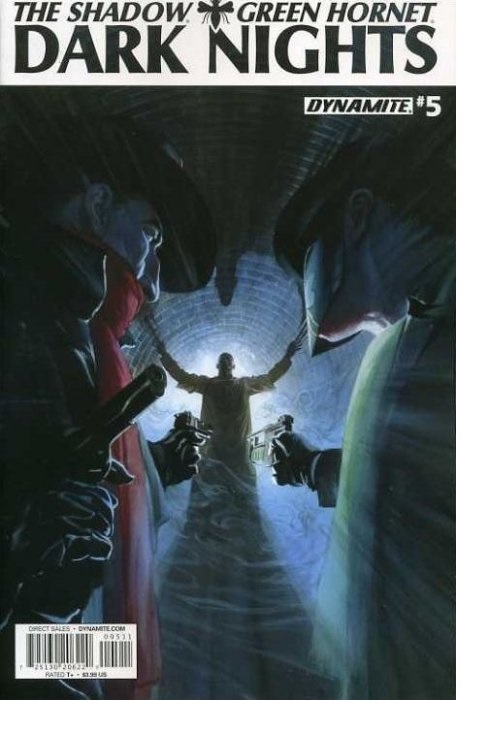
THE SHADOW/GREEN HORNET: DARK NIGHTS #5
Writer: Michael UslanArtist: Keith Burns
Publisher: Dynamite Entertainment
Reviewer: Masked Man
So the great Shadow/Green Hornet crossover comes to a conclusion. As The Shadow teamed up with the Green Hornet, his most famous villain, Shiwan Khan teamed up with the Nazis as they fight it out for the supernatural power of the Girasol--I'm so glad Uslan didn't just use atomic power, which is way too common in these period pieces.
One of the fun things about this series was all the history Uslan liked to pack into each issue. Heck, each issue even had a page devoted to pointing out the true history this comic book is wrapped in, including things like Woodrow Wilson's wife running the country for over a year and American companies helping out the Nazis before the start of WWII. Uslan definitely wanted to make sure this series was packed with as much fun, drama and Easter eggs as he could (including Nikolas Tesla and Howard Hughes).
The final issue was, of course, the final showdown between our heroes and Shiwan Khan. Stealing a page from THE PHANTOM movie (starring Billy Zane) it turns out the Shadow's ring has a more clandestine purpose than what his original writers posed, and The Shadow manages to save the day by using an age old superhero trick all but invented by Gardner Fox. Unfortunately, I felt Burns' storytelling wasn't up to snuff. Panels just didn't describe the action as clearly and as interestingly as in previous issues.
My favorite part of the whole series was Shiwan Khan teaming-up with the Green Hornet (since he poses as a mobster), but like a lot of cool character angles Uslan used, I wish he developed them more. Perhaps this was because he focused on plot too much (which is usually never a bad thing) and not enough on the characters. By this I mean we generally know how The Shadow works to take bad guys down. We know how the Green Hornet works to take bad guys down. What we don't know is how they would work together. I wish we got more contrasting of the heroes and sidekicks, more friction between how they like to operate, what they think about each other…mind you, it's in there; I just wanted more.
Still, I can't see how even a passing fan of The Shadow or the Green Hornet wouldn't enjoy this series. Keith Burns' graphic art style worked well with the book, too. Many of Dynamite's period books can get a little dull-looking in their typical style of comic book realism. Here, Burns gives the pulp heroes more pop and style, using heavy graphic blacks, fitting the mood of each hero.
On the Masked Man's scale of CRAP, POOR, DECENT, GOOD or GREAT, I'm a little torn on how to grade this series. On one hand, I enjoyed it and felt it delivered what it promised: a rousting tale of The Shadow and the Green Hornet teaming up; therefore it's GOOD. On the other hand, I felt it never quite hit the high notes beyond being good enough; therefore it's DECENT. Maybe years from now when I give it a re-read I'll be able to choose for sure.
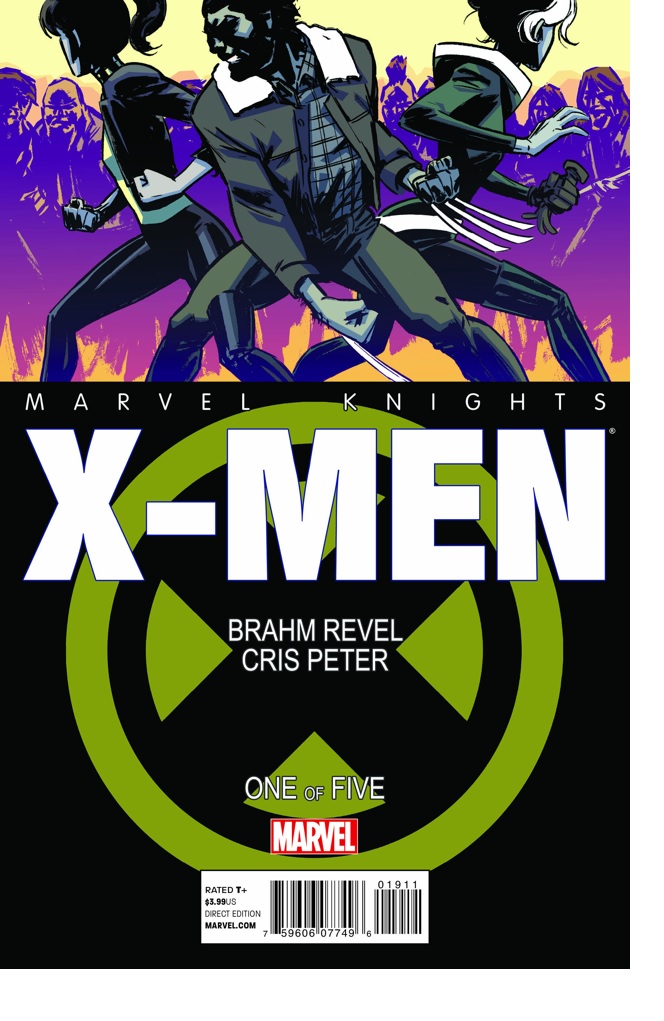
MARVEL KNIGHTS X-MEN #1
Writer: Brahm RevelArt: Cris Peter
Publisher: Marvel Comics
Reviewer: Henry Higgins is My Homeboy
Ooooooh, fancy.
It's been a few years, but the Marvel Knights imprint is back in full swing. The banner saw some of Marvel's most inventive titles (1602, SILVER SURFER: REQUIEM, SPIDER-MAN BLUE) and it's nice to see the imprint plastered across a cover again. The second of these new miniseries may not be as inspired as its contemporary (seriously, go start reading the new MARVEL KNIGHTS: SPIDER-MAN right now--if you have time to read this review, then you have time to go read that comic) but it's still an incredibly well done comic.
Revel writes a traditional X-Men comic, with a small group (Wolverine, Shadowcat, and Rogue) being dispatched to investigate a newly found mutant and a string of murders in the same area. Upon arriving in the small rural town, the trio locates the young mutant and find themselves drawn into a mystery. Each character is well-constructed and believable, even when some of the dialogue falters. But the driving plot is engaging and, much like MARVEL KNIGHTS: SPIDER-MAN, it finds a believable way for the squad to run afoul of countless enemies. Likewise, it takes a simple concept (new mutant for the X-Men to chase after) and gives her some strong characterization very quickly. She's a cipher so far, resourceful and vindictive one moment but mousy when confronted by the team the next. It's in her quietest moments that Krystal fully feels like a real teen, lost and confused like all teens in X-MEN are.
The art by Cris Peter is wonderful. He's able to balance characters against one another and infuse every face with emotion, whether it be a quiet conversation or a tense confrontation. And whenever he pulls back to show off an entire scene? The book looks incredible. Special kudos to the rest of the art team as well, with some of the best colouring I've seen all year courtesy of Christiane Peter. Each area is lit up differently, and Peter is able to use stark colours to show off intensity or dread. Joe Sabino provides the lettering, which ranges from the simple to complex, conveying emotion and action with three letters.
Comparing it to its fellow mini is a losing situation. MARVEL KNIGHTS: X-MEN isn't a revolutionary comic. It doesn't go for the sheer balls out, uncut insanity that MARVEL KNIGHTS: SPIDER-MAN is reaching for, and because of that, it's not quite as memorable. But it's not trying to be. It's trying to be an incredibly solid X-Men comic, produced by a talented crew of comic book writers and artists, and it succeeds. If you want to be a colourist or even want to see how basic hues can be utilized to further a story, then definitely pick this book up. You should also just pick it up if you like good funny books.
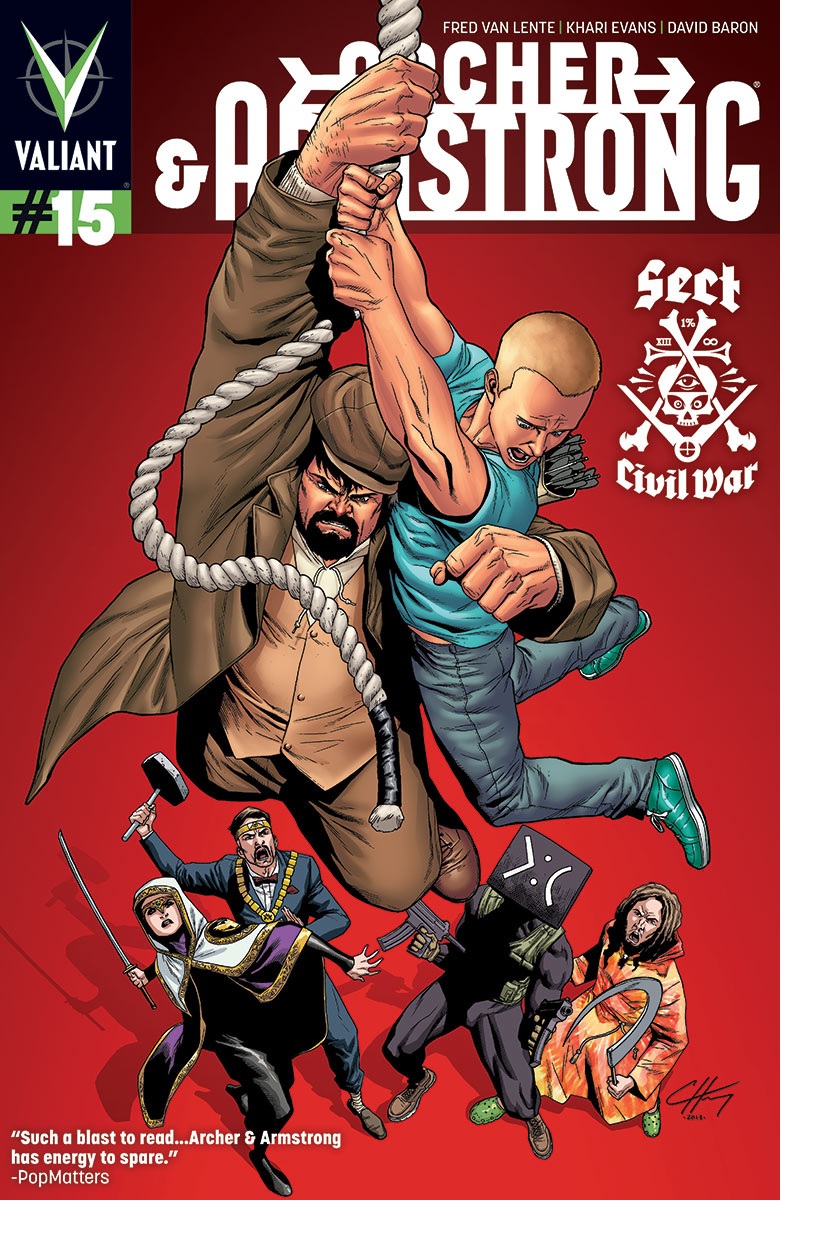
ARCHER & ARMSTRONG #15
Writer: Fred Van LenteArtist: Khari Evans
Publisher: Valiant Entertainment
Reviewer: Optimous Douche
The slovenly and saintly has been a dichotomy played by writers as far back as the Bible (Judas was a real neatnik). TV, movies and theater use this convention constantl,y with the most recent and culturally resonant example of this comedy gold being Neil Simon’s “Odd Couple.” Comics, oddly enough, haven’t dipped into this well too often. Sure, you have characters like Wolverine, but he’s generally in a team book so you can’t really compare that shallow dive into this concept being the driving force behind the plot.
ARCHER & ARMSTRONG is the buddy comedy done right, backed by Valiant’s impeccably clean universe for them to play in. While a disgusting immortal teamed up with a Christian kid from the Midwest who spent most of his life brainwashed might be too much of a leap for some, true comic fans know the well of material that can be mined from this relationship. I’m of course referring to the time long ago when Bush I was in office and we all felt a glimmer of hope for our future – the time when Valiant saved us from anatomical monstrosities and plotlines that were equally shallow. ARCHER & ARMSTRONG in the Valiant universe of old travelled the world and time to right wrongs, get their drink on and start an ideology that would one day become this universe’s most prevalent cult. Not too shabby for a book that was only around for a few scant years.
ARCHER & ARMSTRONG today takes many of these tenets of old, but transforms them for modern day appetites. Where once Archer was a Zen monk akin to Kane from “Kung Fu”, he is now as I mentioned a finely tuned instrument raised by a whacked out religious cult from the Midwest. Armstrong has barely changed; he is still the same immortal looking to party his ass off until the end of everything. While I don’t paint Armstrong in the strongest light, it should be mentioned that there is a heart of gold that shines through every now and then – mainly when he’s drunk.
Even though this issue smacks us right in the middle of the Sect War story, I would say this could be a favorable jumping in point for new readers. Sect War isn’t really an event; it’s merely the devouring of the 1% elite by Toyo Harada. Harada is the big baddie of this universe – sort of. His means can be deplorable, but whether his mission to make a better world is evil will depend on where your personal sensibilities fall. Personally, I’m torn. You can’t make an omelet without breaking a few eggs…or humans endowed with our next evolution of super powers. Sorry--tangents are easy when I discuss Valiant in hopes to show readers all the glory it bestows.
Anyway, so while the Sect War “rages” on (i.e. pretty much devours it self), ARCHER & ARMSTRONG continue on separate paths for this issue. Long story short, Armstrong nailed Archer’s lifelong crush while they spent a few months in a land outside space and time where aliens are just as commonplace as dinosaurs. Fortunately, Archer found an escape hatch to leave his pain behind courtesy a time map he boosted from Armstrong’s brother, Ivar. See, Armstrong isn’t the only immortal floating about in the Valiant U. In addition to Ivar, the displaced time traveler, there’s another Brother who is an Eternal Warrior that protects a Geomancer who speaks with the Earth. Not important for now; just worth mentioning.
This issue is all Ivar and Armstrong as they traverse time on the greatest drinking binge ever conceived. From ancient Egypt to Chicago circa prohibition, these two imbibe the greatest nectars the Gods have ever offered. The travels are replete with infographics to help us keep track of location, mead type and Armstrong’s rapidly dwindling sobriety level. Actually, I need to take another side note on that topic. Where most companies rely on lame paragraphs to get readers up to speed, Valiant has truly imbibed modern marketing practices, making each catch-up an infographic that is beautifully designed and laid out. The marketer in me is often green with envy at this subtle yet effective touch. Of course, the drinking binge turns into catharsis as these events often do. Ivar reminds Armstrong that Archer is not only a good soul, but also that their time together will change humanity. Archer needs a little more convincing given the fat lout scar that sits on his heart.
Evans earns an extra-special reacharound for the work on this issue. Not only are all the usual particulars like clean lines and great expressions in place, but being able to draw backgrounds that span the entire breadth of human history is a feat that most pencilers ignore or can’t achieve in one place and time.
ARCHER & ARMSTRONG and HARBINGER continue to dance between my personal one and two spots in the Valiant lineup; this issue, though, helped eke the team that comedy built slightly ahead…at least for this month.
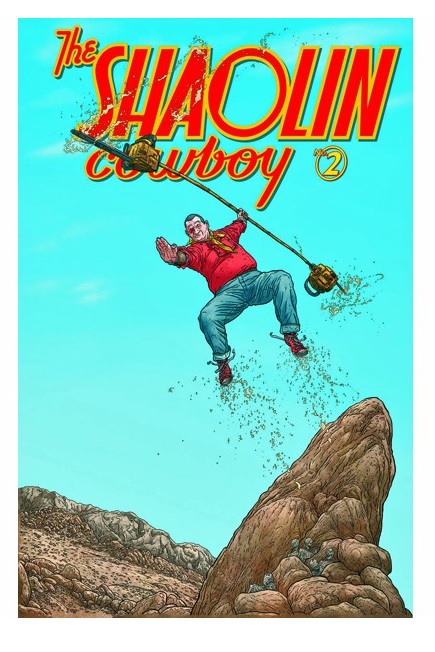
THE SHAOLIN COWBOY #2
Writer: Geof DarrowArt: Geof Darrow
Publisher: Dark Horse Comics
Reviewer: Ambush Bug
I know this is the day and age of the writer/creator, but there are times when I grab a comic when I just want to soak in the artwork, and I know every time Geoff Darrow’s THE SHAOLIN COWBOY comic comes out I’m in for a feast for the eyes. Issue #2 is not just such a comic, but it’s probably the most engrossing single comic I’ve experienced all year. I say experienced because this is a completely silent issue (despite the rumble-grumble of the Cowboy’s trademark double sided chainsaw staff) and reading really doesn’t exist in this issue’s dojo.
At the end of last issue, the titular star of this book burst from the desert floor from his last adventure (which occurred quite some time ago, published from Burly Man Comics, the Wachowski Brothers’ former comic book publishing company) and found himself in the middle of a zombie herd. The last panel of last issue had the cowboy leaping into the thick of the herd, double chainsaw staff in hand, ready to kick major zombie glute.
This issue opens an instant later. In fact, the cover is the first panel of the issue depicting a reverse angle of the Shaolin Cowboy’s leap into the zombie masses. Page one, he is still in mid-air and readying his weapon in a full page splash as worthy for a poster as any I’ve ever seen. For the next 21 pages, each page is a 2-panel split double-page splash as the Cowboy slices, chops, kicks and dices his way through the zombies.
Now, there will be people who will dislike this issue because of its wordlessness. Those weaned on Claremont’s excessive exposition or Bendis’ babble-speak are going to loathe this silent but violent montage of chop-socky mayhem. I understand that there are some who pay for a story and might feel this issue lacking, as this issue is one long fight scene that does not come to a resolution by the end of the issue.
That said, as a sterling example of panel to panel progression in terms of movement and action, this single issue is worthy of study, dissection, and awe. This issue is not just a series of pin-ups only connected by the fact that all of the splashes contain the same guy in the same costume. This is a step-by-step progression of the Shaolin Cowboy cleaving his way through, and we’re along for the ride through every single action. A zombie with a stop sign tramp stamp approaches in one panel, it is sawed in half at the waist in the next panel, and falls in the next, only to crawl towards the cowboy and be karate chopped in the face by the cowboy two beats later. Some might breeze through this book, but to do so is a disservice to the painstaking and jaw-droppingly fine details Geoff Darrow has added to every single page.
As I said, this might not be everyone’s cup of tea, but in a media where writers seem to be trying to outdo each other in word count on a month to month basis, THE SHAOLIN COWBOY is a cold shower wake up call to those who forgot that there are pictures that go with all of the colorful rhetoric. THE SHAOLIN COWBOY #2 has art that gave me fully engorged eye-boners, and if you’re an appreciator of panel-to-panel transition, your irises will be pitching pupil-tents as well.
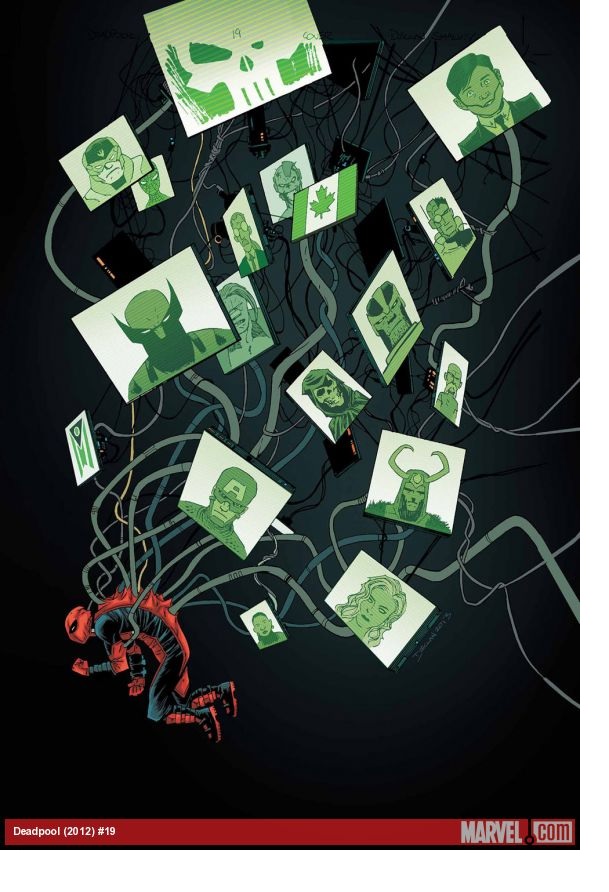
DEADPOOL #19
Writers: Brian Posehn and Gerry DugganArtist: Declan Shalvey
Publisher: Marvel Comics
Reviewer: The Kid Marvel
DEADPOOL #19 concludes the extremely impressive and overall awesome arc ‘The Good, The Bad and The Ugly’, giving the Merc With The Mouth some much-needed depth for the character that has been lacking in his use lately. Posehn and Duggan have showed they can write the entertaining, witty joke telling, nutty fan favorite Deadpool. However, over the last five issues the duo have shown they can also write serious drama and storytelling for the character, adding layers to not only Deadpool, but their own skills as writers. Overall, the Posehn/Duggan duo continues to impress me and solidify my love for Deadpool, expanding his story and my interest in his stories to deeper levels. So without further ado, let me get to my review of DEADPOOL #19.
In DEADPOOL #19 and part five of ‘The Good, The Bad and The Ugly’ we see the conclusion of the Deadpool/Wolverine/Captain America team up against the North Korean army and the man only known as Butler, who has been using Wade’s DNA in an attempt to heal his dying sister, or who may not be, as it is revealed later in the book. Issue #19 begins with Deadpool sifting through possible memories that may be true or could be fabricated by Butler’s various tests over the years, while still dealing with the deaths of a former girlfriend and his daughter at the hands of Butler or the North Koreans. He even questions what he thought about his origins as explained by T-Ray way back when; however, Butler reveals he has no knowledge of this person, stating he could be real or another simulation used during periods when Wade was captured and used for testing. Deadpool eventually makes it into the panic room Butler has trapped himself in, with the help of Butler’s sister, where Deadpool exacts some revenge but giving his past reason for more doubt in the process. Without adding too many more details of the issue into this summary and giving away big spoilers, let me end with this: DEADPOOL #19 ends on a great note, further expanding Deadpool’s character and possibly putting him on a path from anti-hero to actual hero, but leaving a lot of opportunity to expand upon his origin story.
I can’t say enough good things about the Posehn/Duggan run with Deadpool, with each issue not really teetering towards being anything awful, even though some may have been hit or miss; they have never been anything terrible. DEADPOOL #19 and ‘The Good, The Bad and The Ugly’ arc in general, is a great use in transitioning from the mouthy and more upbeat Deadpool to the darker, more tormented individual also associated with the character. This is especially true because most writers or uses of Deadpool are usually the Merc With The Mouth persona rather than focusing on the Wade Wilson inner being. I liked seeing the maturity being attached to Deadpool and the use of character growth, especially since, again, Wade’s writing is usually associated with him being an immature clown and annoying almost all of the Marvel Universe. Not that I dislike Deadpool’s wide range of fart jokes and humor in situations of death, but it’s an enjoyable change to show layers to the character and depth, which adds to why he is one of Marvel’s favorite class clowns and what brings about his insanity.
As for the art, I really enjoyed Declan Shalvey’s work in the book. The use of low detail, combined with the use of shadowing and gritty shading, really worked for the story and the poorer environments of North Korea. The flashback artwork for Deadpool was also a nice touch, with minimal detail of environment and color, making the pages only focused on the actions of Wade’s jumbled memory. I honestly really enjoyed Shalvey’s design and artwork for the issue, feeling it definitely added to the story itself.
The DEADPOOL NOW series is definitely one that you should be reading if you aren’t already. The stories have been mixed and varied, creating very entertaining reads without getting boring or stagnant. I’m excited to see where Posehn and Duggan take Deadpool, continuing to add to this chaotic, crazy, hilarious, and completely awesome character.
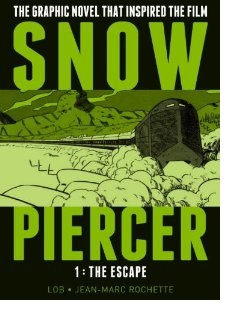 Advance Review: January 2014!
Advance Review: January 2014!SNOWPIERCER VOL 1. THE ESCAPE OGN
Writer: Jacques LobArtist: Jean-Marc Rochette
Publisher: Titan Comics
Reviewer: Optimous Douche
Imagine, if you will, a train. Not a super train--that shit is soooooo 1970s. I’m talking about a train that embodies all of society, each car a sub-facet of our own culture carrying the virtues and vices of humanity through a frozen wasteland, a train that is in a desperate search for salvation that could be nothing more than a fairytale. Sound familiar? Good--that means you are a fully actualized human being who will understand the allegory for the current and future state of mankind that SNOWPIERCER draws through this haunting mirror of a comic.
When I first saw the movie trailer for SNOWPIERCER before it was released in South Korea this past summer, I didn’t get it. That’s Hollywood for you, though, taking everything meaningful from the original work so it ends up just being about a big fucking train plowing through snow. I also didn’t quite understand why humanity would rush for a train in the face of imminent doom and destruction, and won’t the rails end pretty quickly? Then I remembered I’m an American and there’s other continents like Europe where this book was written, and Asia where the book takes place, and train travel is still quite popular in both. I’m used to riding NJ Transit and SEPTA, with train cars barely fit for short durations, much less long term living. Apparently, though, there are trains that take luxury into account at every turn. Given this cultural education, I found the hyperbolic stretch about a train 1001 cars long complete with ghettos, aristocrats, synthetic meat vats and a religion that deifies the sacred life-bearing engine much more palatable.
Our story starts with Proloff, a man condemned to the rear cars of the Snowpiercer. This area is starkly reminiscent of the trains that shuttled Jews to the concentration camps during WWII. Living conditions are deplorable--people sustain themselves on rat meat and little else. Proloff is able to escape this area, and we’ll learn at the end how and why, but for now he escapes and begins a long journey towards salvation at the front.
We don’t know how long since the cataclysm that made the land uninhabitable, but it has been less than a full generation. The train’s inhabitants still remember life before the endless winter and still imbibe some of the dwindling stock of pleasures like wine, food and cinema that make life worth living. It might not sound like a Herculean task to get from one end of a train to another, even a really big train--I mean hell, hobos do it all the time. Imagine a train, though, where every square inch is occupied-- where narrow cars become even narrower. Also add in the human propensity to protect squatters’ rights and you get a feel for how arduous this journey will be. If you can’t imagine this scenario, Rochette’s fine black and white pencils will gladly paint the picture for you.
Rochette also portrays quite aptly the horrors of all classes when they are left with no ambition to better society and merely fritter away the days engaging in our most carnal instincts to pass the time. As Proloff moves to the front, with military escort and our ingénue, a lovely liberal looking to help the ghetto cars named Adeline, we see how different classes in this future and today are all disgusting--simply in different ways. The ghettos kill for staples, the upper class kill brain cells and their genitals for fun.
Eventually, after some diversions past the vat-grown meat car called Mama and the horticulture car, Proloff and Adeline meet the first class, specifically the President. This was the only part of the book I found predictable. The train is slowing down and must lose some cars to continue its journey. Even though it’s a perpetual motion engine, inertia will win unless the load is lightened. The President assures Proloff he will move the back passengers, but I guessed pretty quickly this guy was all evil and was going to simply cast the cars off without moving their residents forward.
Like WALKING DEAD, this is apocalypse done right. It focuses on the human reaction to abandonment of societal constraints rather than the inciting event. The rest of the book is a big surprise; nothing ends well for anyone. Yet, there’s still a glimmer of…not exactly hope, but the belief that humans can overcome any adversity. Or perhaps we would rather suffer in the known rather than shuffle loose our mortal coil and roll the dice against eternal darkness. Either way, I have no doubt this team will tackle both possibilities when Volume 2 is translated to English for those of us who used to fall asleep in French class.
Proofs, co-edits & common sense provided by Sleazy G
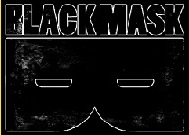 Find out what are BLACK MASK STUDIOS and OCCUPY COMICS here and on Facebook here!
Find out what are BLACK MASK STUDIOS and OCCUPY COMICS here and on Facebook here! Want more in all things Geek?
Want more in all things Geek?Check out PoptardsGo and on Facebook here!
 Get your copy of highly-anticipated anthology TOME by 44FLOOD here!
Get your copy of highly-anticipated anthology TOME by 44FLOOD here!Check out AICN COMICS on Facebook and Comixpedia.org!
